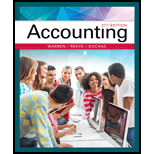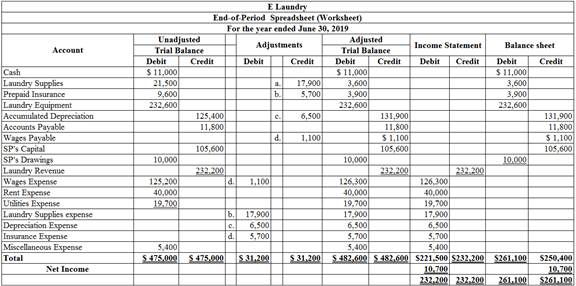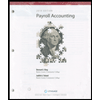
Concept explainers
T accounts,
The unadjusted
| Epicenter Laundry Unadjusted Trial Balance June 30,2019 |
||
| Debit Balances | Credit Balances | |
| Cash | 11,000 | |
| Laundry Supplies | 21,500 | |
| Prepaid Insurance | 9,600 | |
| Laundry Equipment | 232,600 | |
| 125,400 | ||
| Accounts Payable | 11,800 | |
| Sophie Perez, Capital | 105,600 | |
| Sophie Perez, Drawing | 10,000 | |
| Laundry Revenue | 232,200 | |
| Wages Expense | 125,200 | |
| Rent Expense | 40,000 | |
| Utilities Expense | 19,700 | |
| Miscellaneous Expense | 5,400 | |
| 475,000 | 475,000 | |
The data needed to determine year-end adjustments are as follows:
a. Laundry supplies on hand at June 30 are $3,600.
b. Insurance premiums expired during the year are $5,700.
c. Depreciation of laundry equipment during the year is $6,500.
d. Wages accrued but not paid at June 30 are $1,100.
Instructions
1. For each account listed in the unadjusted trial balance, enter the balance in a T account. Identify the balance as "June 30 Bal." In addition, add T accounts for Wages Payable, Depreciation Expense, Laundry Supplies Expense, and Insurance Expense.
2. (Optional) Enter the unadjusted trial balance on an end-of-period spreadsheet and complete the spreadsheet. Add the accounts listed in part (1) as needed.
3. Journalize and post the adjusting entries. Identify the adjustments as "Adj." and the new balances as "Adj. Bal."
4. Prepare an adjusted trial balance.
5. Prepare an income statement, a statement of owner's equity (no additional investments were made during the year), and a
6. Journalize and
7. Prepare a post-closing trial balance.
1, 3, and 6:
Journal:
Journal is the book of original entry. Journal consists of the day-to-day financial transactions in a chronological order. The journal has two aspects; they are debit aspect and the credit aspect.
T-Accounts:
T-accounts are referred as T-account because its format represents the letter “T”. The T-accounts consists of the following:
Ø The title of accounts.
Ø The debit side (Dr) and,
Ø The credit side (Cr).
Adjusted trial balance:
The unadjusted trial balance is the summary of all the ledger accounts that appears on the ledger accounts before making adjusting journal entries.
Adjusting entries:
An adjusting entry is prepared when the trial balance is not up-to-date, and complete, and they are usually prepared at the end of the accounting period. This adjusting entry is essential for preparing the financial statements of the business.
Spreadsheet:
A spreadsheet is a worksheet. It is used while preparing a financial statement. It is a type of form having multiple columns and it is used in the adjustment process. The use of a worksheet is optional for any organization. A worksheet can neither be considered as a journal nor a part of the general ledger.
Statement of owners’ equity:
This statement reports the beginning owner’s equity and all the changes, which led to ending owners’ equity. Additional capital, net income from income statement is added to and drawing is deducted from beginning owner’s equity to arrive at the end result, ending owner’s equity.
Income statement:
An income statement is one of the financial statements which shows the revenues, and expenses of the company. The income statement is prepared to ascertain the net income/loss of the company, by deducting the expenses from the revenues.
Balance sheet:
A balance sheet is a financial statement consists of the assets, liabilities, and the stockholder’s equity of the company. The balance of the assets account must be equal to that of the liabilities and the stockholder’s equity account.
Closing entries:
Closing entries are recorded in order to close the temporary accounts such as incomes and expenses by transferring them to the permanent accounts. It is passed at the end of the accounting period, to transfer the final balance.
Post-Closing Trial Balance:
After passing all the journal entries and the closing entries of the permanent accounts and then further posting them to each of the respective accounts, a post-closing trial balance is prepared which consists of a list of all the permanent accounts. A post-closing trial balance serves as an evidence to prove that the balance of the permanent accounts is equal.
To prepare: The T-accounts.
Explanation of Solution
Record the transactions directly in their respective T-accounts, and determine their balances.
| Cash | |||||||||||
| June 30 | Balance | 11,000 | |||||||||
| Laundry Supplies | |||||||||||
| June 30 | Balance | 21,500 | June 30 | Adjusted | 17,900 | ||||||
| June 30 | Adjusted balance | 3,600 | |||||||||
| Prepaid Insurance | |||||||||||
| June 30 | Balance | 9,600 | June 30 | Adjusted | 5,700 | ||||||
| Adjusted balance | 3,900 | ||||||||||
| Laundry Equipment | |||||||||||
| June 30 | Balance | 232,600 | |||||||||
| Accumulated Depreciation | |||||||||||
| June 30 | Balance | 125,400 | |||||||||
| June 30 | Adjusted | 6,500 | |||||||||
| June 30 | Adjusted balance | 131,900 | |||||||||
| Accounts Payable | |||||||||||
| June 30 | Balance | 11,800 | |||||||||
| Wages Payable | |||||||||||
| June 30 | Adjusted | 1,100 | |||||||||
| SP, Capital | |||||||||||
| June 30 | Closing | 10,000 | June 30 | Balance | 105,600 | ||||||
| June 30 | Closing | 10,700 | |||||||||
| June 30 | Balance | 106,300 | |||||||||
| SP, Drawing | |||||||||||
| June 30 | Balance | 10,000 | June 30 | Closing | 10,000 | ||||||
| Laundry Revenue | |||||||||||
| June 30 | Closing | 232,200 | June 30 | Balance | 232,200 | ||||||
| Wages Expense | |||||||||||
| June 30 | Balance | 125,200 | June 30 | Closing | 126,300 | ||||||
| June 30 | Adjusted | 1,100 | |||||||||
| June 30 | Adjusted balance | 126,300 | |||||||||
| Rent Expense | |||||||||||
| June 30 | Balance | 40,000 | June 30 | Closing | 40,000 | ||||||
| Utilities Expense | |||||||||||
| June 30 | Balance | 19,700 | June 30 | Closing | 19,700 | ||||||
| Depreciation Expense | |||||||||||
| June 30 | Adjusted | 6,500 | June 30 | Closing | 6,500 | ||||||
| Laundry Supplies Expense | |||||||||||
| June 30 | Adjusted | 17,900 | June 30 | Closing | 17,900 | ||||||
| Insurance Expense | |||||||||||
| June 30 | Adjusted | 5,700 | June 30 | Closing | 5,700 | ||||||
| Miscellaneous Expense | |||||||||||
| June 30 | Balance | 5,400 | June 30 | Closing | 5,400 | ||||||
2.
To enter: The unadjusted trial balance on an end-of-period spreadsheet, and complete the spreadsheet.
Explanation of Solution
The unadjusted trial balance on an end-of-period spreadsheet is prepared as follows:

Table (1)
Hence, the unadjusted trial balance on an end-of-period spreadsheet is prepared and completed.
3.
To Journalize and post: The adjusting entries.
Explanation of Solution
The adjusting entries are journalized as follows:
| Date | Description | Debit ($) | Credit ($) | |
| 2019 | Wages expense | 1,100 | ||
| June | 30 | Wages payable | 1,100 | |
| (To record the wages accrued) | ||||
Table (2)
Explanation:
- Wages expense is an expense account, and it is increased. Hence, debit the wages expense account by $1,100.
- Wages payable is a liability account, and it is increased. Hence, credit the wages payable account by $1,100.
| Date | Description | Debit ($) | Credit ($) | |
| 2019 | Depreciation expense | 6,500 | ||
| June | 30 | Accumulated depreciation | 6,500 | |
| (To record the equipment depreciation) | ||||
Table (3)
Explanation:
- Depreciation expense is an expense account, and it is increased. Hence, debit the wages expense account by $6,500.
- Accumulated depreciation is a contra asset account, and it is increased. Hence, credit the accumulated depreciation account by $6,500.
| Date | Description | Debit ($) | Credit ($) | |
| 2019 | Laundry supplies expense | 17,900 | ||
| June | 30 |
Laundry supplies
| 17,900 | |
| (To record the equipment depreciation) | ||||
Table (4)
Explanation:
- Laundry supplies expense is an expense account, and it is increased. Hence, debit the laundry supplies expense account by $17,900.
- Laundry supplies are the asset account, and it is increased. Hence, credit the laundry supplies account by $17,900.
| Date | Description | Debit ($) | Credit ($) | |
| 2019 | Insurance expense | 5,700 | ||
| August | 31 | Prepaid insurance | 5,700 | |
| (To record the equipment depreciation) | ||||
Table (5)
Explanation:
- Insurance expense is an expense account, and it is increased. Hence, debit the insurance expense account by $5,700.
- Prepaid insurance is an asset account, and it is decreased. Hence, credit the prepaid insurance account by $5,700.
4.
To prepare: An unadjusted trial balance for Laundry E, as of June 30, 2019.
Explanation of Solution
Prepare an unadjusted trial balance for Laundry E, as of June 30, 2019.
| Laundry E | ||
| Unadjusted Trial Balance | ||
| June 30, 2019 | ||
| Accounts | Debit Balances | Credit Balances |
| Cash | 11,000 | |
| Laundry Supplies | 3,600 | |
| Prepaid Insurance | 3,900 | |
| Laundry Equipment | 232,600 | |
| Accumulated depreciation | 131,900 | |
| Accounts payable | 11,800 | |
| Wages Payable | 1,100 | |
| SP, Capital | 105,600 | |
| SP, Drawing | 10,000 | |
| Laundry revenue | 232,200 | |
| Wages expense | 126,300 | |
| Rent expense | 40,000 | |
| Utilities Expense | 19,700 | |
| Depreciation Expense | 17,900 | |
| Laundry supplies expense | 6,500 | |
| Insurance Expense | 5,700 | |
| Miscellaneous Expense | 5,400 | |
| 482,600 | 482,600 | |
Table (6)
5.
Explanation of Solution
The net income of Laundry E for the month of June is $10,700.
| E Laundry | ||
| Income Statement | ||
| For the year ended June 30, 2019 | ||
| Particulars | Amount ($) | Amount ($) |
| Revenue: | ||
| Laundry revenue | $248,000 | |
| Expenses: | ||
| Wages Expense | $126,300 | |
| Rent Expense | 40,000 | |
| Utilities Expense | 19,700 | |
| Depreciation Expense | 17,900 | |
| Laundry supplies Expense | 6,500 | |
| Insurance Expense | 5,700 | |
| Miscellaneous Expense | 5,400 | |
| Total Expenses | 221,500 | |
| Net Income | $10,700 | |
Table (7)
Hence, the net income of Laundry E for the year ended June 30, 2019 is $10,700.
6.
To Journalize: The closing entries for E Laundry.
Explanation of Solution
Closing entry for revenue and expense accounts:
| Date | Accounts title and Explanation | Post Ref. |
Debit ($) |
Credit ($) |
| June 30, 2019 | Laundry Revenue | 232,200 | ||
| Wages Expense | 126,300 | |||
| Rent Expense | 40,000 | |||
| Utilities Expense | 19,700 | |||
| Depreciation Expense | 17,900 | |||
| Laundry supplies Expense | 6,500 | |||
| Insurance Expense | 5,700 | |||
| Miscellaneous Expense | 5,400 | |||
| SP, Capital | 10,700 | |||
| (To close the revenues and expenses account. Then the balance amount are transferred to owners’ capital account) | ||||
| June 30 | SP’s Capital | 10,000 | ||
| SP’ Drawing | 10,000 | |||
| (To Close the capital and drawings account) | ||||
Table (10)
Explanation:
- Laundry revenue is revenue account. Since the amount of revenue is closed, and transferred to SP’s capital account. Here, E Laundry earned an income of $232,200. Therefore, it is debited.
- Wages Expense, Rent Expense, Insurance Expense, Utilities Expense, Laundry Supplies Expense, Depreciation Expense, SP Capital, and Miscellaneous Expense are expense accounts. Since the amount of expenses are closed to Income Summary account. Therefore, it is credited.
- Owner’s capital is a component of owner’s equity. Thus, owners ‘equity is debited since the capital is decreased on owners’ drawings.
- Owner’s drawings are a component of owner’s equity. It is credited because the balance of owners’ drawing account is transferred to owners ‘capital account
7.
To prepare: The post–closing trial balance of E Laundry for the month ended June 30, 2019.
Explanation of Solution
Prepare a post–closing trial balance of E Laundry for the month ended June 30, 2019 as follows:
|
Laundry E Post-closing Trial Balance June 30, 2019 | ||
| Particulars | Debit $ | Credit $ |
| Cash | 11,000 | |
| Laundry Supplies | 3,600 | |
| Prepaid insurance | 3,900 | |
| Laundry Equipment | 232,600 | |
| Accumulated depreciation | 131,900 | |
| Accounts payable | 11,800 | |
| Wages payable | 1,100 | |
| BD’s Capital | 106,300 | |
| Total | 251,100 | 251,100 |
Table (11)
The debit column and credit column of the post–closing trial balance are agreed, both having balance of $251,100.
Want to see more full solutions like this?
Chapter 4 Solutions
Working Papers, Chapters 18-26 for Warren/Reeve/Duchacâs Accounting, 27E
- Nexus Builders Inc. reported a Cost of Goods Sold (COGS) for the current year of $560,000. During the same period, the Inventory account increased by $25,000, and the Accounts Payable account decreased by $15,000. The amount of cash paid to suppliers for inventory is: A. $520,000 B. $585,000 C. $600,000 D. $535,000arrow_forwardCan you help me solve this general accounting problem using the correct accounting process?arrow_forwardGeneral accounting questionarrow_forward
- RWW Stores has total debt of $7,850 and a debt-equity ratio of 0.65. What is the value of the total assets? HELParrow_forwardCan you explain this general accounting question using accurate calculation methods?arrow_forwardI am looking for the correct answer to this financial accounting problem using valid accounting standards.arrow_forward
- Century 21 Accounting Multicolumn JournalAccountingISBN:9781337679503Author:GilbertsonPublisher:Cengage
 Intermediate Accounting: Reporting And AnalysisAccountingISBN:9781337788281Author:James M. Wahlen, Jefferson P. Jones, Donald PagachPublisher:Cengage Learning
Intermediate Accounting: Reporting And AnalysisAccountingISBN:9781337788281Author:James M. Wahlen, Jefferson P. Jones, Donald PagachPublisher:Cengage Learning Cornerstones of Financial AccountingAccountingISBN:9781337690881Author:Jay Rich, Jeff JonesPublisher:Cengage Learning
Cornerstones of Financial AccountingAccountingISBN:9781337690881Author:Jay Rich, Jeff JonesPublisher:Cengage Learning





